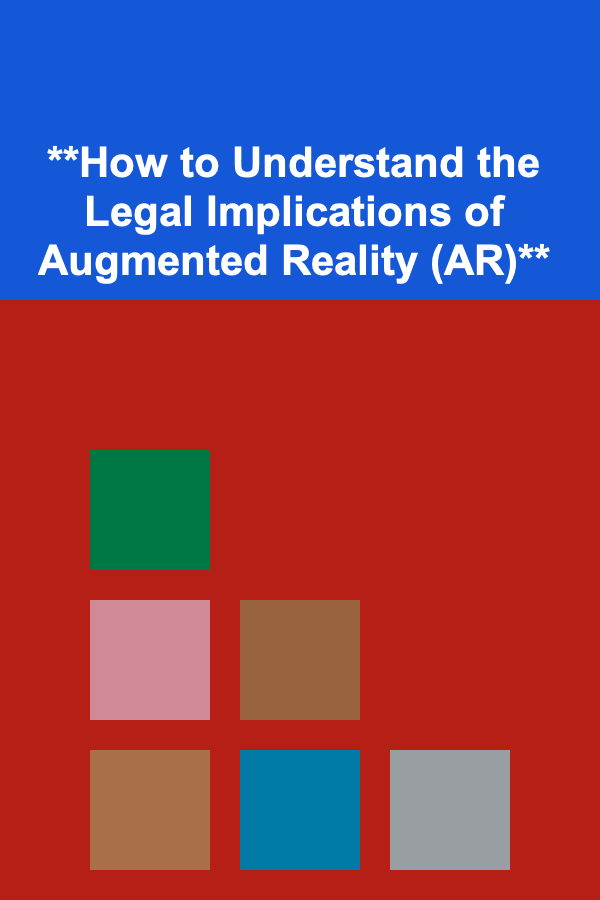
**How to Understand the Legal Implications of Augmented Reality (AR)**
ebook include PDF & Audio bundle (Micro Guide)
$12.99$7.99
Limited Time Offer! Order within the next:

How to Understand the Legal Implications of Augmented Reality (AR)
Introduction
Augmented Reality (AR) is one of the most transformative technological advancements in recent years, influencing multiple industries such as gaming, education, healthcare, retail, and even law enforcement. As AR continues to evolve, its legal implications are becoming an area of increasing importance. AR blends the physical world with digital overlays, often creating immersive experiences that blur the line between what is real and what is virtual. However, this exciting new frontier also introduces a range of legal challenges that must be addressed to ensure the responsible use and development of AR technologies.
Understanding the legal implications of AR requires navigating complex issues related to intellectual property, privacy, consumer protection, liability, and safety. This article aims to explore these key legal concerns while also offering a comprehensive overview of the legal landscape surrounding AR.
1. Intellectual Property in AR
1.1 Copyright Issues
As AR creates interactive experiences by blending real-world environments with digital content, questions arise regarding copyright and ownership. Many AR experiences rely on user-generated content, third-party digital assets, and software to function, which could potentially result in copyright disputes.
- Copyright of Digital Assets: The digital components that make up AR experiences, such as 3D models, animations, and textures, are often copyrighted works. However, there may be confusion over who owns these assets if they are integrated into an AR platform. Is the user who creates the content the copyright holder? Or does the platform owner, who provides the tools for creation, hold the rights? This issue is compounded by the fact that AR experiences are often collaborative, with content coming from multiple sources.
- Copyright Infringement: AR applications may include digital representations of real-world objects, locations, or people. This raises concerns about whether such representations infringe on existing copyrights, particularly when virtual objects are displayed over real-world landmarks or products. For instance, AR games like Pokémon Go might inadvertently depict copyrighted characters or locations, leading to potential legal challenges from intellectual property holders.
1.2 Patent Considerations
AR technology itself is protected by various patents, covering everything from hardware to software. As AR becomes more prevalent, patent disputes may arise over the underlying technologies. The question of who owns patents related to AR will likely be central to disputes within the industry.
- Hardware Patents: The development of AR hardware, including headsets, glasses, and even smartphones, has led to an array of patent filings. Companies that create these devices need to ensure they do not infringe upon existing patents for tracking systems, display technologies, or gesture control. Similarly, patent trolls could target smaller companies in the AR space, leading to legal battles over patent rights.
- Software Patents: Beyond the hardware, the software that drives AR applications is also subject to intellectual property protection. Whether it's the algorithms used to track real-world objects or the system design of an AR app, developers must be aware of existing patents and ensure their creations do not infringe upon them.
2. Privacy Concerns in AR
2.1 Data Collection and Consent
One of the most pressing legal implications of AR is related to privacy and data protection. Many AR applications rely on collecting data about users' environments, behaviors, and even biometric information in real-time. This raises questions about how that data is stored, shared, and protected.
- Personal Data: AR applications often gather vast amounts of personal data, from location information to facial recognition data. The General Data Protection Regulation (GDPR) in the European Union and other privacy laws across the world are tightening regulations on how personal data can be used. Companies developing AR technologies must ensure they comply with these regulations by obtaining explicit consent from users before collecting any personal data and by offering the option to opt-out at any time.
- Facial Recognition and Biometric Data: AR systems that use facial recognition technology or other biometric data (such as fingerprints or retina scans) raise additional privacy concerns. While facial recognition is widely used in AR applications such as virtual try-ons or personalized experiences, the use of biometric data without informed consent can lead to serious legal consequences. Many jurisdictions require explicit permission from individuals before collecting biometric data, and in some cases, such data may be subject to stricter regulations due to its sensitive nature.
2.2 Geolocation and Surveillance
AR apps often use geolocation technology to enhance the user experience by providing location-based information. While this can be beneficial for navigation and gaming, it also opens up the possibility for surveillance and tracking without users' knowledge or consent.
- Location Tracking: For example, AR gaming applications might track players' movements in the real world to allow for immersive experiences. If the location data is mishandled, shared with third parties without consent, or used to track individuals without a valid purpose, users may face privacy violations. This raises concerns about whether AR applications are following best practices regarding geolocation data usage, such as minimizing data retention and anonymizing personal information.
- Surveillance Risks: The integration of AR with public spaces could lead to concerns about mass surveillance. For example, augmented reality glasses with built-in cameras and facial recognition software could enable the collection of data on people without their knowledge or consent. This could be seen as an infringement on personal privacy, especially if the data is used for purposes such as surveillance or profiling.
3. Consumer Protection and Safety
3.1 Consumer Liability
As with any new technology, AR carries inherent risks for consumers. Whether it's the potential for physical harm while engaging with AR environments or financial losses from deceptive marketing, legal frameworks must adapt to these new challenges.
- Injuries and Accidents: AR applications that require physical movement, such as in immersive gaming or fitness applications, pose a risk of injury. Users may become so immersed in the virtual world that they fail to notice obstacles in the real world, leading to accidents. Developers must ensure that their applications include adequate warnings about potential dangers, such as the need for a safe play area or the risks of long-term use.
- Misleading Advertising: Some AR applications use virtual try-ons or visual product demonstrations to entice consumers into making purchases. However, there is a risk that these AR representations could mislead consumers about the quality or appearance of products. Consumer protection laws will need to address whether AR-driven marketing constitutes false or deceptive advertising, especially if the digital representations are significantly different from the real-world product.
3.2 Safety Regulations for AR Hardware
The development of AR hardware, such as headsets and glasses, presents additional legal challenges. If these devices are not safe for use, manufacturers could be held liable for damages. Product liability laws will need to adapt to ensure that AR devices are safe and free from defects.
- Device Safety: AR headsets, for instance, can cause physical discomfort, including eye strain, headaches, or even long-term vision problems. Manufacturers will need to ensure their devices meet rigorous safety standards. Furthermore, if the technology malfunctions and causes harm, consumers may have grounds for legal claims under product liability laws.
- Safety Standards: Jurisdictions will need to establish and enforce safety standards for AR technologies. This may include setting guidelines for ergonomics, electromagnetic radiation levels, and the safe use of AR devices in public or workplace settings.
4. Liability and Accountability in AR
4.1 Responsibility for AR Content
One of the biggest challenges in the legal regulation of AR is determining liability in the case of harm or damage caused by AR content. For instance, if a user is harmed due to misleading AR advertising or inappropriate content, who should be held accountable?
- Content Providers vs. Platforms: Often, AR platforms host content created by third parties. In this case, it can be difficult to assign liability. Should the platform itself be held responsible for any harm caused by user-generated content, or should the content creators be held accountable? The legal framework for AR will need to clarify the responsibilities of both platforms and content providers.
4.2 Cybersecurity Threats
The integration of AR with various digital systems and devices introduces new risks of cybersecurity threats. Malicious actors may attempt to hack into AR applications to steal personal data, disrupt service, or alter AR content in harmful ways.
- Data Breaches: AR applications that store sensitive personal data must comply with cybersecurity regulations and safeguard against breaches. If a breach occurs and personal data is exposed, companies could face significant fines and lawsuits under data protection laws.
- Manipulated AR Content: Hacking into AR systems could also result in malicious content being displayed to users. For example, a hacker might manipulate an AR game to display incorrect information, or use AR to create fake visualizations that mislead users.
Conclusion
The legal implications of Augmented Reality are vast and complex, covering a wide range of issues such as intellectual property, privacy, safety, and liability. As AR technology continues to develop, it is crucial for policymakers, developers, and consumers to understand and address the legal challenges that arise. Companies must ensure they comply with existing laws and regulations while also working to create a framework that protects the rights of users and promotes innovation.
As with any emerging technology, the legal landscape surrounding AR will continue to evolve. The key to managing the legal implications of AR lies in staying ahead of these changes, fostering collaboration between stakeholders, and creating an environment that balances innovation with responsibility. By doing so, we can unlock the full potential of AR while safeguarding the rights of individuals and society as a whole.

How to Make Your Home Smell Like the Holidays Using Natural Scents
Read More
How to Plan Your Home's Security for Different Life Stages
Read More
How to Prevent Clutter from Accumulating in Your Home
Read More
How to Sell Used Appliances on Letgo: A Comprehensive Actionable Guide
Read More
How to Use Blogging to Drive Traffic to Your Dropshipping Business
Read More
How to Get Cheap Accommodation in Major Cities
Read MoreOther Products

How to Make Your Home Smell Like the Holidays Using Natural Scents
Read More
How to Plan Your Home's Security for Different Life Stages
Read More
How to Prevent Clutter from Accumulating in Your Home
Read More
How to Sell Used Appliances on Letgo: A Comprehensive Actionable Guide
Read More
How to Use Blogging to Drive Traffic to Your Dropshipping Business
Read More